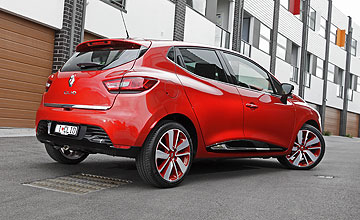BY MIKE COSTELLO | 4th Sep 2013

For now, it’s available in three specification levels – Authentique, Expression and Dynamique – with a pair of two turbocharged petrol engines, including Renault’s first three-cylinder. There’s no three-door version available either here or in Europe.
Under global boss Carlos Ghosn, Renault has placed more emphasis on build quality. The attention to detail and fit-and-finish inside the Clio’s cabin is almost Teutonic, with the added bonus of some French flair.
The touchscreen system (with sat-nav) available from the Expression up is first-rate, the oval-shaped digital speedo is retro-cool, and the ability to add plastic trim in the same colour as the body paint is a novel touch. Light blue steering wheel anyone? This design savvy extends to the exterior, because the curvaceous Clio is not far short of stunning in the metal. It looks classy, chic and far more expensive than it is. I quizzed a small group of people - none of them car enthusiasts - on what they guessed would be the Clio’s starting price, and they all said north of $30k.
But as promised, the Clio is priced smack-bang among key rivals such as the Volkswagen Polo and Ford Fiesta from $16,790 plus on-road costs for the Authentique, and climbing to $23,290 for the Dynamique.
The Authentique gets a decent level of standard equipment including cruise control with speed limiter, a rear spoiler, LED daytime running lights and USB/Bluetooth.
All versions bar the base get sat-nav, which is deeply impressive, and the flagship version gets Renault’s R-Link infotainment, which among other things includes a sound simulator that pipes the exhaust note of a racing bike or classic old-school cruiser through the cabin. Very cool.
The front seats are snug and the steering wheel has acceptable levels of adjustment. Pedal positioning is also first-rate - not always the case with French cars - while front head ad shoulder room is excellent.
It’s squeazy in the back but about par for the course, although the roof-mounted centre belt is an ergonomic pain, and the lack of rear head-protecting airbags is difficult to justify, no matter how tough the bodyshell is. Renaults say the Clio’s Euro NCAP five-star rating vindicates it, though.
The 360 litres of boot space out back is better than usual, and there’s even a full-size spare under the car with a very clever (and dead simple) release mechanism that drops the wheel with detachment of a cable.
Entry versions get a 900cc triple-cylinder turbo engine producing 66kW at 5250rpm and 135Nm at 2500rpm. It has a less-distinctive thrum than many other three-pots, but that’s likely because overall sound-deadening and NVH levels are better than the norm for this end of the market.
You do need to work the little engine to some degree, although the relatively strong low-down torque helps cruising - at 100km/h, the tacho reads 2600rpm.
With only five forward ratios (and no automatic option) the Clio seems limited in the transmission stakes, but in reality to gearbox is a fine unit, with a light and accurate take-up and clutch feel.
Despite our thoughts, the lack of a base automatic will hurt sales in Australia, no question. The cheapest automatic Clio kicks off at $19,790 for the Expression TCe 120, which uses the larger of the two engines on offer.
We didn’t match Renault’s claim of using 4.5 litres per 100km of fuel for the triple, but under spirited driving we came close.
All Clios get rear drum brakes, not uncommon in this segment, but we experienced no issues with stopping power or with fade. This car weighs around 1100kg, remember.
Naturally, the direct-injected 88kW at 4900rpm and 190Nm at 2000rpm 1.2-litre turbo four-cylinder under the nose of higher-spec versions is better for enthusiastic driving (it flies the flag until the 147kW RS arrives).
There’s no perceptible lag, although the EDC dual-clutch automatic (no manual option this time) does seem to limit off-the-line acceleration. It lacks the immediacy of Volkswagen’s 77kW 1.2 turbo used in the Polo, for instance. It also lacks the Polo’s DSG kinks at take off, however.
In terms of handling, the regular Clios benefit from the development of the forthcoming RS. It features an exceptionally stiff chassis, maintaining composure and balance mid-corner and turning in with bite and gusto. We carried some pretty commendable corner speeds.
Likewise, the ride balance is excellent on the 15- or 16-inch wheels. NVH, as mentioned, is minimised, but it’s the way the Clio dispatched bigger corrugations that impressed us. It has many of the attributes of a larger car.
That electric steering is too light and inert, however. It’s programmed for urban-dwellers and to help with parking, which is fair enough, though it takes the edge off driver confidence in trickier conditions.
From an ownership perspective, the Clio is an increasingly solid bet. As well as a five-year, unlimited kilometre warranty, buyers are entitled to three-years of capped price servicing capped at $299 per annum (12-month/15,000km intervals). Glass’s also projects a retained value in-line with class heavies such as the Mazda2.
In other words, the Clio brings to the table all that we like about French cars - design flair and style - with added extras such as sharp value and affordable ownership. The outstanding design will net more than a few on its own, but there’s plenty of substance to the style too.
Class leaders such as the Fiesta and Polo have a serious challenger, and that’s no small feat.